Quick, agile CX-3 swaps room for 38+ mpg
By John Gilbert
Our younger son, Jeff, sent us a carefully selected gift combining a birthday (that would be my wife, Joan) and father’s day (that’d be me). It was a pair of well-positioned seats for the Bruce Hornsby concert at Big Top Chautauqua in mid-July.
Located just a few miles south of Bayfield, Wis., we’ve always enjoyed spending a summer evening at a Big Top concert after an afternoon strolling around the shops and waterfront of Bayfield.
It would be more memorable this time, because we’d never seen Bruce Hornsby. Jeff insisted he has rounded up a high-skilled backup band and he knew we had never seen them, plus he knew we’d enjoy the show. On top of that, it was the perfect opportunity to test my long-standing theory about how small SUVs can often outdo larger vehicles, because my test-vehicle of the week was a glistening metallic-white Mazda CX-3.
With Mazda selling a large CX-9 for those who need to carry three rows-worth of seats-full, and a slick CX-5 for those compact crossover types who are shopping Honda CR-V, Toyota RAV4, Nissan Rogue, and Hyundai Tucson SUVs, the CX-3 is aimed at the new, still more compact, crossovers.
With technology at the forefront of the newest vehicles, Mazda has that covered. Mazda builds a potent 2.5-liter 4-cylinder that works well in the CX-9 with a turbocharger, or normally-aspirated in the CX-5 and large-sedan Mazda6. The same Skyactiv technology works even more impressively on the 2.0-liter 4-cylinder — which has become my favorite Mazda engine in either the Mazda3 or the CX-3.
It revs quickly, packs a punch beyond what its 146-horsepower/146-foot-pounds of torque might imply, and gets fantastic fuel economy. I was alerted that the newest CX-5 with G-Vectoring and the larger engine, would be a better choice because it is only 1 mpg off the 2.0. The EPA estimates may not be duplicated in real-world tests, however, a fact I realized after the 2.0 showed more like 10-12 mpg better than the 2.5. Maybe it helps to stay off long-haul, high-speed freeways.
We had earlier taken a drive up the North Shore of Lake Superior to Grand Marais, the little artsy Minnesota town that just won the award as the best small town in the U.S. The CX-3 handled that daytrip with ease, and it was more of the same heading for Bayfield.
Big Top Chautauqua is always a nice trip from Duluth, Mn., being just under 100 miles, at an estimated time of just under 2 hours. You travel through lightly populated areas on good highways whether you take Wisconsin 13 close to the South Shore of Lake Superior or the more mainline Hwy. 2 to Washburn and then drive North on 13. The huge blue and white tent at Big Top Chautauqua sits at the bottom of a ski hill and houses amazing acoustics and a schedule filled with impressive performers. We usually take Hwy. 2, but this time we took Hwy. 13 and came into Bayfield from the North.
With a full tank of gasoline, and some snackable mixed nuts and cans of Perrier, our Mazda Touring CX-3 was ready to renew my personal philosophy: Anything bigger than big enough is too big. Aside from being cumbersome to maneuver and no fun to drive, large SUVs are just waiting for fuel prices to climb.
Mazdas, meanwhile are always fun to drive, whether sports car, small sedan, large sedan, or SUV. The CX5 handles like a sports sedan and has the added power of the 2.5, but I can’t imagine anyone accusing the CX3 of being anything but peppy. Unless it is to compliment it on being an incredible over-achiever when it comes to fuel economy.
I’ve often found that the numbers don’t matter to validate Mazda vehicles, and they often don’t add up in assessing its engines. We were not flying at 75 or 80, but stayed comfortably within the 60 or 65 mph speed limit all the way down and back. We clicked the house-built 6-speed automatic into “normal” setting or “sport” mode, which stiffens the suspension, firms up the steering, holds the revs higher in each gear, and blocks out the overdrive and super-overdrive fifth and sixth gears.
As we drove, I watched the computerized fuel device climb, up to 30 miles per gallon, and then higher, and higher. When we pulled into the trendy little town of Bayfield, that gauge said 38.4 miles per gallon! Thirty-eight point four? Compact or not, this is an all-wheel-drive SUV that could turn hillside climbs up snowy and icy hills a simple and even joyful procedure. And it delivered 38.4.
The CX-5 with the 2.5 got about 27, which is good for an AWD SUV, but we found the CX-3 compromise on space was a small price for the exchange. The front bucket seats are supportive and comfortable, and the driver’s instrument cluster is concise and easy to read, with a large speedometer in the middle, and other instruments in the two smaller enclosures, the left one encircled by a tachometer. An easily operated switch racks over the information that appears inside the speedometer, ranging from tire pressure, to remaining fuel range, to current fuel economy.
Even in normal setting, the CX-3 has handling stability and quick-reacting response to steering input. At one point, I spotted a young deer running through a field parallel to Hwy. 13, and I was ready to take evasive action if it decided to veer onto the road. It didn’t, and we cruised on.
We had plenty of room under the rear hatch to stow all the stuff we brought along, and I must say that we were pleasantly surprised earlier in the week when our older son, Jack, who is 5-11, climbed into the rear seat and declared that he had adequate headroom, and the leg and foot room was fine, as long as we didn’t slide the seats back all the way.
The move to Skyactiv has been criticized by some, and ignored by others, who simply don’t understand the complexities. It was a move made by Mazda to counteract the obvious technological breakthrough Hyundai had made in South Korea back in 2010, designing a superb new engine to win joint-venture engine-building competition with Fiat-Chrysler and Mitsubishi, and adding unprecedented features such as direct-injection. It caught the Japanese manufacturers trapped possibly by their own complacency, and Mazda was first to break out, with an entirely new way to build engines.
Carefully redesigning every facet of the engine, Mazda ended up with a gem, combining the sort of high-performance pistons, connecting rods, crankshaft, the best features of Miller-cycle and Atkinson cycle to alter intake and exhaust valves to more thoroughly burn fuel, via computerized efficiency and a unique 4-into-2-into-1 exhaust system. In total, the engine operates at an extremely high 14-to-1 compression ratio — unprecedented for a production engine — to assure top power production and maximum fuel efficiency.
The 6-speed automatic transmission works in harmony, as does the suspension and stiff chassis, all of which are coordinated to fit into the Skyactiv concept of unifying all elements of building a vehicle. All Mazda engines are Skyactiv, and such over-the-top technical advances make its price seem equally outrageous. In base form, a CX-3 can be obtained in the under-$25,000 region, and loading up with all-wheel drive and all the prized options can boost it up to $30,000.
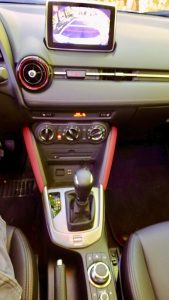
Center console houses switches for screen readouts, connectivity, USB jacks and CX-3 suspension firmness.
Because there is no longer a Mazda dealer in the Duluth area, the dramatic confluence of contours and accent lines that come together on the CX-3’s striking appearance, back of the large grill opening. Parking on the main street in downtown Bayfield allowed us to wander among the shops and occasionally see other pedestrians pause to examine the vehicle.
Bruce Hornsby, by the way, put on a superb show, with his own brilliance on piano augmented by spectacular lead guitar, drums, bass, violin and electronic keyboard. His biggest hit, “The Way It Is,” was the show’s highlight as the band started deceptively then erupted into the familiar refrain, and carried on through elongated solos by each band member. I want that version on a CD. And I don’t know when I’ve ever seen a band that was having as much outright fun on stage.
Afterward, the drive home took us until after midnight, but it was smooth and comfortable all the way. The optional 18-inch wheels, by the way, may have added to the higher-speed handling, but I had to think 17s or 16s might have softened the ride more, and let us use the toggle switch to firm things.
The idea of making the shape and the size of a car or SUV work together with the powertrain and interior features, such as connectivity, cubicles and comfy seats, is not new. It just seems new because nobody seems to pull it off with the coordinated effort Mazda puts into all its vehicles.
When you drive away, or make a sharp turn, or relax on a long drive, you realize that bringing together the advanced engine-transmission with the suspension and solidly built body and frame, is something special.
And when the fuel economy gauge clicks up to “38.4,” you wonder what the reaction would be of all those people who discount the importance of fuel economy because of low gas prices. I count it toward engineering credit, and realiz Mazda’s “zoom-zoom” mantra is more than just throwing a Miata around a tight curve.


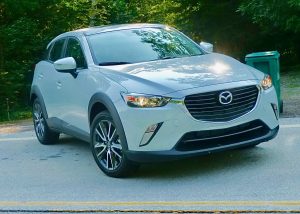
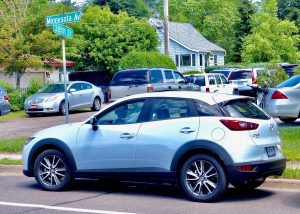
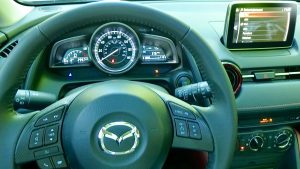
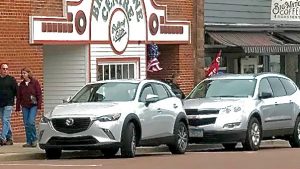
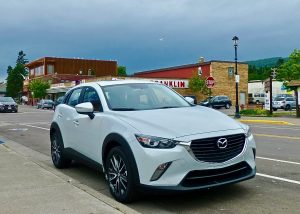
 John Gilbert is a lifetime Minnesotan and career journalist, specializing in cars and sports during and since spending 30 years at the Minneapolis Tribune, now the Star Tribune. More recently, he has continued translating the high-tech world of autos and sharing his passionate insights as a freelance writer/photographer/broadcaster. A member of the prestigious North American Car and Truck of the Year jury since 1993. John can be heard Monday-Friday from 9-11am on 610 KDAL(www.kdal610.com) on the "John Gilbert Show," and writes a column in the Duluth Reader.
John Gilbert is a lifetime Minnesotan and career journalist, specializing in cars and sports during and since spending 30 years at the Minneapolis Tribune, now the Star Tribune. More recently, he has continued translating the high-tech world of autos and sharing his passionate insights as a freelance writer/photographer/broadcaster. A member of the prestigious North American Car and Truck of the Year jury since 1993. John can be heard Monday-Friday from 9-11am on 610 KDAL(www.kdal610.com) on the "John Gilbert Show," and writes a column in the Duluth Reader.